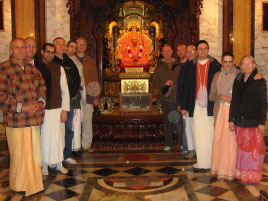
New Vrindaban Board Members with Srila Prabhupada at his Palace, April 2013.
Monthly Meeting Minutes of the Boards of Directors for ISKCON New Vrindaban & ECOV - 8/15/13.
ISKCON New Vrindaban (INV) Vision Statement: Founded in 1968, Srila Prabhupada boldly envisions New Vrindaban as a sacred place known worldwide for Cow Protection, Self-Sufficiency, Holy Pilgrimage, Spiritual Education, and, above all, Loving Krishna.
ECOV Mission Statement: ECOV (Earth, Cows, Opportunities & Vrindaban Villages) is dedicated to cow protection, sustainable agriculture, self-sufficiency and simple living — all centered around loving service to Sri Krishna, as envisioned by the ISKCON New Vrindaban Founder-Acharya, His Divine Grace A.C. Bhaktivedanta Swami Prabhupada.
Present from INV: Jaya Krsna, Dayavira, Chaitanya Mangala, Gopisa, Ranaka & Jamuna.
Present from ECOV: Madhava Gosh, Kripamaya, Navin Shyam, Chaitanya Mangala & Ranaka.
Recording Secretary: Laxmi Honest
The first item of discussion was the Palace restoration. The sub-committee met on 8/9/13 and they decided to send out an international call for a project manager. Kripamaya suggested that we also contact senior devotees and sanyasis such as Radhanatha Swami for people they may know who are engineers and so forth. Gopisa mentioned that the Palace front steps renovation project is very hard, heavy work and we really need younger people to do it. Gopisa has estimates from private contractors ranging from $65,000 to $115,000, not including materials, which would be an additional $25,000. He expects a response by 8/16 from a company in Pittsburgh and will email the joint boards with updates.
Jaya Krsna then began a discussion regarding the desire of HH Bhakti Raghava Swami to create a Varnashrama Eco-Village at the Old Vrindaban farm. The proposed community would strive to be self-sufficient. Bhakti Raghava Swami reports that he has already set up such a village in Indonesia which has been very successful. Jaya Krsna will email for review some possible steps toward accomplishing this goal. Madhava Gosh mentioned that ECOV would be willing to offer food bearing trees to the project. Overall, board members expressed enthusiasm for the project and ideas were exchanged regarding how it might manifest. It was decided that a “straw vote” would be taken to determine potential future acceptance of the proposal by the two boards. Both boards voted in favor of the concept.
The next agenda item was the funding of Gopal’s Garden School. Ranaka reported that the school will need about $24,000 to cover expenses for the 2013-2014 school year. Both boards reconfirmed their commitment to the school and acknowledged its importance in our continued efforts towards developing a more vibrant community. In previous years, this funding has been split between INV and ECOV. At their last meeting ECOV approved $12,000. Ranaka explained that the funds will not be needed within the next 30 days. Dayavira suggested that INV table the item until the next meeting so that they could discuss how best to fund their portion of the budget.
Next, Gopisa gave an update on the Bahulaban projects. Madhava Gosh asked about the repairs to the roof of the utility building. Gopisa said that he talked to some workers in regards to patching holes and generally repairing the roof. He will give a full report at the next meeting. The demolition of the pink building is complete and the question was raised of whether or not to bury the remaining wood scrap, which still has a small amount of foam adhering to it. Jamuna had researched the environmental impact of this and reported that the impact would be negligible. It was proposed that the balance of the wood be buried at a spot in lower Bahulaban. Both Boards voted in favor of the motion.
Lastly, in a discussion of improving community spirit, Madhava Gosh reiterated the need for additional transparency in management. Board members agreed on the importance of continuing to improve communications.

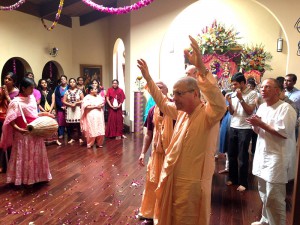


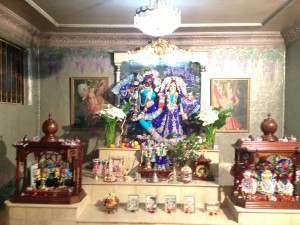

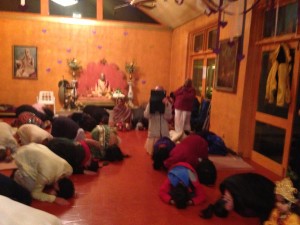
 44 photos: Harinama under the rain in Moscow City, Russia, Gorky Park
44 photos: Harinama under the rain in Moscow City, Russia, Gorky Park 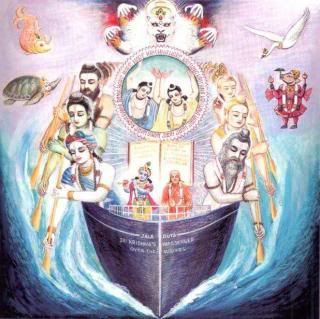
 Avatari Games Team: On Janmastami day we got approval from Apple and have launched our first Lion-Man Avatar game based on Prahlad-Narsimhadeva pastime on the Apple Store
Avatari Games Team: On Janmastami day we got approval from Apple and have launched our first Lion-Man Avatar game based on Prahlad-Narsimhadeva pastime on the Apple Store  Lakshman Poddar: ISKCON Bangkok is managed by GBC (Governing Body Committee). H.H Jayapataka Swami is the GBC, H.H Kavicandra Swami is the co-GBC and H.H B.V.V Narasimha Swami is the regional secretary of Thailand. H.H Vedavyasa Priya Swami also visits and preaches in Thailand. They are all Srila Prabhupada sannayasi disciples and initiating Guru in ISKCON
Lakshman Poddar: ISKCON Bangkok is managed by GBC (Governing Body Committee). H.H Jayapataka Swami is the GBC, H.H Kavicandra Swami is the co-GBC and H.H B.V.V Narasimha Swami is the regional secretary of Thailand. H.H Vedavyasa Priya Swami also visits and preaches in Thailand. They are all Srila Prabhupada sannayasi disciples and initiating Guru in ISKCON  A record number of British Hindus have flocked to one of Europe's largest Krishna temples as part of Janmashtami celebrations this week
A record number of British Hindus have flocked to one of Europe's largest Krishna temples as part of Janmashtami celebrations this week  Quite a few of the Srila Prabhupada disciples who were at our reunion in the Village Hall the day before had turned out. See if you can spot them in the exciting video below
Quite a few of the Srila Prabhupada disciples who were at our reunion in the Village Hall the day before had turned out. See if you can spot them in the exciting video below  50 photos: Harinama during Sri Krishna Janmashtami Festival in Abranovce, Presov, Slovakia
50 photos: Harinama during Sri Krishna Janmashtami Festival in Abranovce, Presov, Slovakia 
 Thousands of happy devotees partecipated in this significant annual vaishnava event!
Thousands of happy devotees partecipated in this significant annual vaishnava event! 